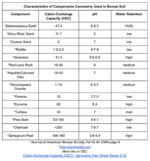Eric Schrader
Chumono
Since you're a technical guy - you should explore that a bit.I'm not anti-lava, just lazy. I don't know what advantage lava has over pumice, so I only use pumice and it's one less material to stockpile.
Here are a couple relevant bits from "Soilless Culture: Theory and Practice" 2e by Raviv, Lieth and Bar-Tal:
Pumice is an inert aluminosilicate material composed primarily of silica and A1-oxide but also may contain metal oxides, calcite or salts. Pumice has no buffering capacity and possesses a very low surface charge, derived mainly from carbonate and metal impurities. Caution is required when applying fresh pumice material because high concentrations of Na may be initially leached.
Tuffs (lava) have permanent and variable charge surface characteristics resulting mainly from amorphous materials. Tuff exhibits a significant buffering capacity and may absorb or release nutrients, especially P, during the growth season (Silber et al., 1999; Silber and Raviv, 1996). The chemical stability of tuff depends on the mineralogical composition.
So my takeaway is that the differences are in the residual minerals that will leach and their ability to hold nutrients. Total porosity is similar as are the water retention curves. And based on the numbers alone (which vary from one source to another!) lava is actually a better substrate than pumice because of the nutrient retention factor.
Empirically, I would note that myself and many others find that performance of lava and pumice as media is significantly improved by washing prior to use. I assume this removes much of the excess salts that would otherwise be present in high quantities in the container. The practice of drying to bone-dry and then sifting is essentially to the same purpose but less effective.
I have been using neither for a while in favor or perlite, which does not leach minerals. But this is actually turning out to be a problem because it's so inert that once other soil components (Coco in my case) break down a bit the soil is totally inert.








